Release creativity with hands-on art projects that transform everyday materials into masterpieces! Try collaborative murals for group expression, junk sculptures using recyclables, or flipbook animation to bring stories to life. Nature-inspired collages, textile crafting, and botanical printing connect art with the outdoors. Clay modeling develops spatial thinking while digital art fusion blends traditional techniques with technology. Creative journaling combines visual and written expression for personal growth. These fifteen engaging projects open doors to artistic discovery beyond the ordinary.
Key Takeaways
- Collaborative murals and junk sculptures encourage group creativity while teaching valuable communication and problem-solving skills.
- Nature-inspired collages and botanical printing connect art creation with environmental awareness and sustainable practices.
- Mixed media techniques combine diverse materials like cardboard, fabric, and found objects to create textured, dimensional artworks.
- Clay modeling and textile crafting develop fine motor skills while offering tactile experiences that promote mindfulness and stress relief.
- Digital art fusion and flipbook animation blend traditional artistic methods with technology for engaging storytelling opportunities.
Collaborative Murals: Unleashing Group Creativity
Every successful collaborative mural begins with a spark of shared imagination. Middle school students love these colorful projects because they get to work together, blending their ideas into one amazing creation.
When kids team up on these artistic adventures, they build communication skills as they plan, compromise, and bring their vision to life on a shared canvas.
Teachers can tie murals to subjects like history or science, making learning more vibrant and memorable. The process naturally boosts critical thinking as students figure out how to divide the work and solve design challenges together.
When art meets academics, students develop both creative vision and practical skills for tackling complex challenges as a team.
The best part? When the finished mural hangs proudly in the hallway, everyone feels that special buzz of accomplishment. These art projects aren’t just about painting—they’re about problem-solving, building confidence, and celebrating artistic expression as a community.
Junk Sculptures: Transforming Trash Into Artistic Treasures
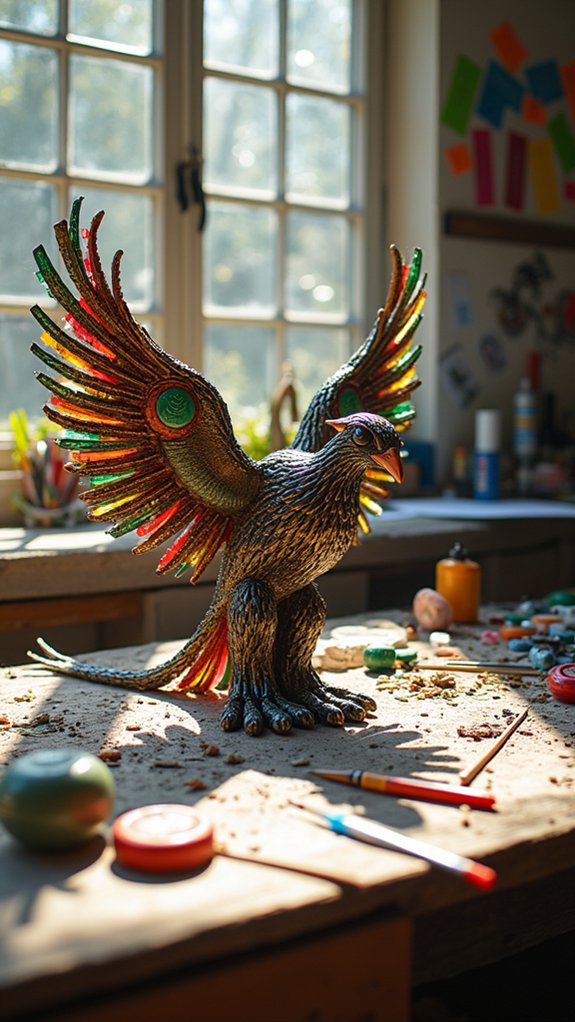
While ordinary trash heads to landfills, creative minds see potential masterpieces hiding in everyday junk. Junk sculptures transform discarded items into amazing artistic treasures that wow viewers while teaching important lessons about waste. Kids love turning bottle caps, cardboard tubes, and broken toys into cool 3D creations!
| Material | Sculpture Idea | Difficulty Level |
|---|---|---|
| Plastic Bottles | Space Rocket | Easy |
| Cardboard Boxes | Robot Friend | Medium |
| Tin Cans | Wacky Animals | Medium |
| Metal Scraps | Abstract Art | Challenging |
Creating junk sculptures builds problem-solving skills and fine motor coordination, plus it sparks awesome conversations about recycling! Schools and community centers often display these eco-friendly masterpieces, inspiring others to look at their trash differently. Who knew garbage could become such a treasure trove of artistic possibilities?
Flipbook Animation: Creating Moving Stories With Simple Tools
Flipbook animation brings stories to life through the simplest of tools – just paper and pencils! This classic technique transforms a stack of drawings into a mini-movie when flipped quickly, creating the illusion of movement that will amaze friends and family.
Among popular craft activities, flipbooks stand out because they combine art with storytelling in a dynamic way.
Students can create flipbooks using small, uniform-sized paper or sticky notes, focusing on making slight changes between each drawing. The magic happens in the shifts!
The entire project fits neatly into one or two class periods, making it perfect for artists of all skill levels. By emphasizing key movements rather than every detail, young animators learn to tell compelling visual stories while having a blast!
Nature-Inspired Collages: Bringing the Outdoors to Your Art
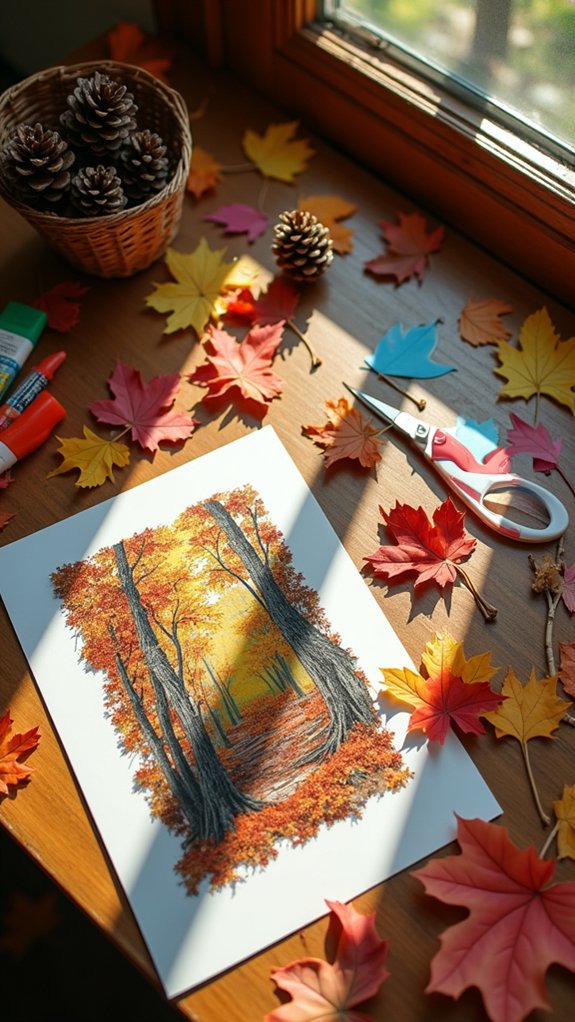
Nature-inspired collages offer an invigorating way to transform ordinary outdoor treasures into extraordinary art! By gathering leaves, flowers, twigs, and other natural materials, kids create stunning compositions while connecting deeply with the environment around them.
These hands-on projects do more than just look pretty—they’re mini adventures! Hunting for the perfect pine cone or vibrant autumn leaf gets children outdoors, boosting their mood and reducing stress. As they arrange their findings, they’re secretly building fine motor skills and spatial awareness too.
Nature-inspired collages easily blend into science lessons about ecosystems and biodiversity. Plus, using materials that Mother Nature provides teaches sustainability in a fun, practical way.
Who knew that a simple arrangement of seeds, petals, and bark could simultaneously develop creativity, environmental awareness, and important physical skills?
Textile Crafting: Exploring Fabric and Fiber Arts
Textile crafting opens a vibrant new world where ordinary threads and fabrics transform into extraordinary works of art!
Crafters can experiment with sewing, weaving, knitting, and dyeing techniques to express their unique creative vision. Even better, using fabric scraps from old clothes gives these projects an eco-friendly twist while reducing waste.
Research shows that working with textiles isn’t just fun—it’s good for you! The focus required to follow patterns or create stitches helps develop fine motor skills and improves concentration.
Crafting isn’t just a hobby—it’s mindful exercise for your brain and fingers!
Many crafters report feeling calmer and happier when they’re working with fiber arts.
This billion-dollar global industry proves that people everywhere love textile crafting.
Whether you’re making a simple friendship bracelet or a complex quilt, fabric arts offer endless possibilities for creative expression and personal growth!
Printmaking Projects: Discovering Multiple Impression Techniques
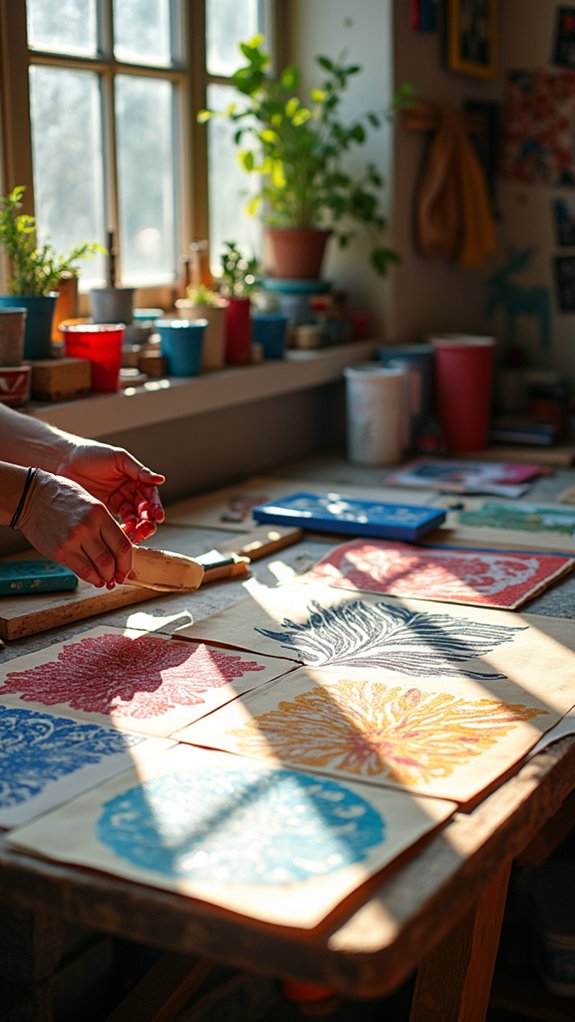
While fabric crafts let you create with threads and textiles, printmaking offers a completely different artistic adventure! This technique transforms ordinary materials into amazing printing tools that can stamp designs onto paper again and again.
Relief printing is super fun to try—just carve a design into linoleum or wood, roll ink onto the raised parts, and press it onto paper. Voilà!
For those who love details, intaglio techniques like etching create incredibly intricate prints by trapping ink in tiny carved lines.
Screen printing makes bold, eye-popping designs perfect for t-shirts or posters.
And if you’re feeling extra creative, try monotype printing for one-of-a-kind masterpieces that can never be exactly duplicated. Each printmaking method tells your artistic story in its own special way!
Mixed Media Masterpieces: Combining Materials for Unique Effects
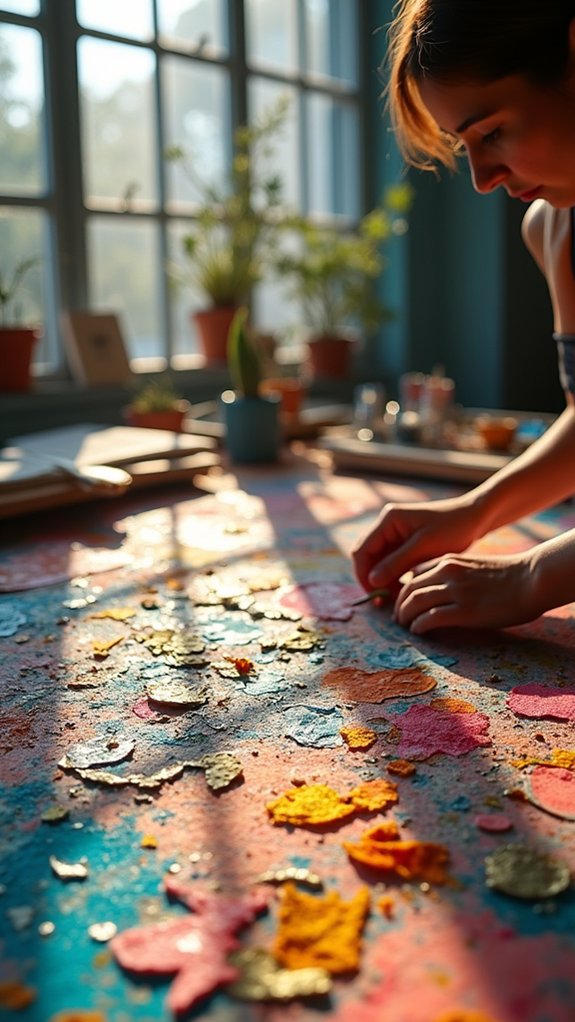
Mixed media art invites young artists to explore the magic of combining unexpected materials like fabric, buttons, and paint to create wildly unique pieces.
Layering different textures—smooth paper over rough cardboard, or sparkly beads nestled in dried glue—creates artwork with actual depth that practically jumps off the page!
These projects offer endless possibilities for personal expression, allowing creators to mix and match materials that speak to them, whether it’s incorporating magazine cutouts, nature finds, or even recycled items that might otherwise end up in the trash.
Texture Through Layering
Diving into the world of texture can transform ordinary art into extraordinary masterpieces. When artists layer different materials—like torn paper over painted backgrounds, or fabric pieces beneath translucent tissue—they create depth that practically jumps off the page!
These tactile creations invite viewers to not just look, but almost reach out and touch.
Mixed media techniques offer endless possibilities for texture enthusiasts. Try sprinkling sand into wet paint for a gritty beach scene, or crumple tissue paper before gluing it down for awesome wrinkled effects!
Many artists start with a base layer, then build up with heavier materials, creating a fascinating visual journey through their work.
The best part? There’s no wrong way to experiment with texture. Each surprising combination might lead to your next creative breakthrough!
Unexpected Material Combinations
When everyday objects become artistic treasures, the real magic of mixed media begins! Artists love exploring unexpected material combinations to create pieces that pop with texture and meaning. By mixing materials like fabric scraps, bottle caps, or even leaves with traditional art supplies, creators can tell unique visual stories that grab attention and spark curiosity.
| Material | Pairs Well With | Creates |
|---|---|---|
| Cardboard | Watercolor paint | Dimensional vistas |
| Beach glass | Wire | Shimmering mobiles |
| Old maps | Acrylic paint | Nostalgic collages |
| Fabric scraps | Embroidery thread | Tactile portraits |
| Bottle caps | Polymer clay | Funky sculptures |
These surprising combos aren’t just super cool—they’re also eco-friendly! Recycling everyday items into art teaches us to see possibilities everywhere, turning “trash” into treasures that amaze and inspire!
Mixed Media Expression Techniques
The artistic journey continues as creators explore the boundless realm of mixed media expression techniques! By combining paint, fabric, paper, and found objects, young artists can create works with amazing texture and depth.
Each material brings its own special qualities to the artwork, making the final piece more interesting and emotionally powerful. These techniques help develop artistic skills through experimentation.
Try layering different materials, making collages, or assembling 3D creations! The cool thing about mixed media is that there are no strict rules—you can mix watercolors with magazine cutouts, add fabric scraps, or include leaves and buttons.
Many artists use these combinations to tell stories or comment on important issues in our world, showing how different parts of life connect, just like the materials in their artwork.
Shadow Puppet Theaters: Storytelling Through Light and Silhouettes
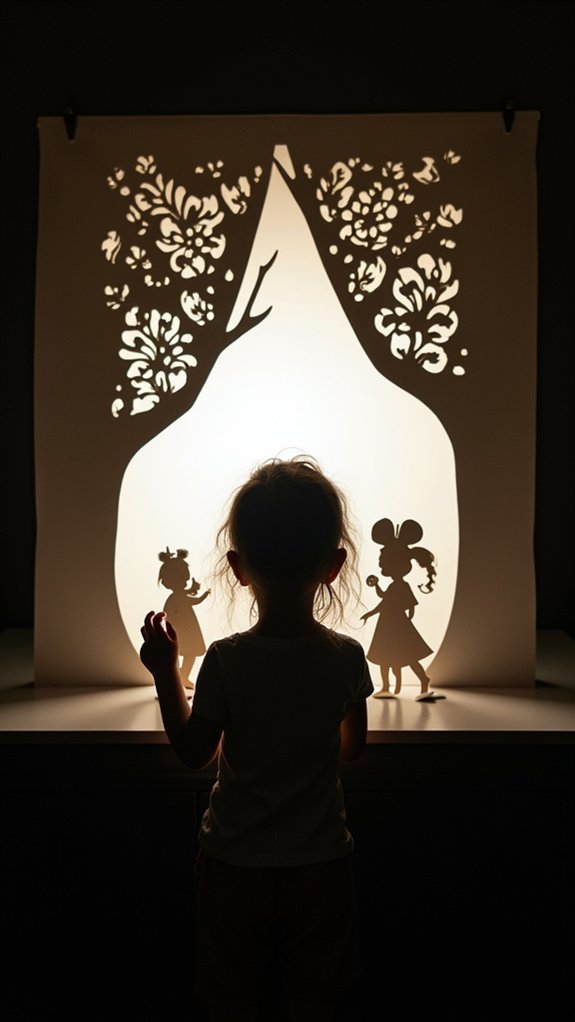
Shadow puppets bring ancient storytelling magic to life, enchanting audiences with nothing more than light, shadow, and imagination. These activities offer children a chance to connect with an art form that’s been mesmerizing people for centuries across Asia.
With just a flashlight, white sheet, and cardstock, kids can create entire worlds!
What makes shadow puppetry special:
- Characters come alive through silhouettes, turning simple cutouts into dramatic performers
- Kids develop literacy skills while crafting original stories and dialogue
- Team performances build communication as puppeteers work together behind the screen
This ancient art form transforms ordinary materials into extraordinary adventures.
When children design their own puppets and perform their stories, they’re not just making crafts—they’re becoming part of a tradition that spans continents and centuries.
Upcycled Fashion: Reinventing Old Clothing With Artistic Flair
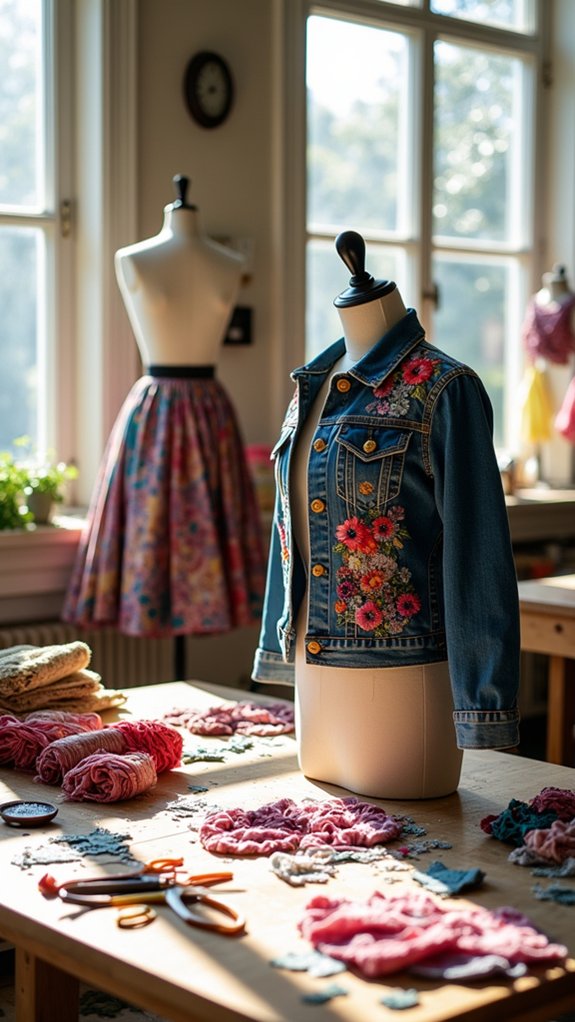
Breathing new life into old clothes, upcycled fashion offers eco-friendly ways to express creativity through techniques like tie-dyeing faded t-shirts, transforming plain jackets with vibrant fabric paints, or adding personality with patchwork designs.
These artistic approaches not only reduce textile waste but also create one-of-a-kind pieces that showcase your unique style without breaking the bank.
Social media is bursting with amazing before-and-after transformations that will totally inspire you to grab those forgotten clothes from the back of your closet and turn them into your new favorite fashion statements!
Tie-Dye Clothing Revival
Few fashion trends have experienced such a colorful renaissance as tie-dye, which has burst back onto the scene with renewed enthusiasm and creative potential.
This hands-on technique transforms boring clothes into eye-popping masterpieces that scream personal style! By folding, twisting, and binding fabric before adding vibrant dyes, anyone can create one-of-a-kind patterns that showcase their creativity.
What makes tie-dye so awesome?
- It’s super inclusive – everyone from kids to grandparents can join the fun!
- Using eco-friendly dyes makes it part of the sustainable fashion movement
- The finished pieces can be worn, given as gifts, or even sold
This collaborative activity brings people together while breathing new life into old clothing, making it both an artistic expression and a practical way to reduce waste in our closets.
Fabric Paint Transformations
While tie-dye brings explosive color to fashion, another creative technique has fashion enthusiasts buzzing with excitement. Fabric paint transformations are revolutionizing wardrobes everywhere, turning forgotten clothes into walking masterpieces! Old t-shirts, jeans, and jackets get amazing makeovers when artists apply fabric paint using stencils or freehand designs.
The magic happens when creativity meets sustainability. By upcycling clothing that might otherwise end up in landfills, crafters create unique fashion pieces that scream personality. Adding fabric medium to paint guarantees the designs survive countless wash cycles without fading or cracking.
The best part? Anyone can do it! From simple polka dots to intricate scenes, fabric painting lets middle schoolers express themselves while developing artistic skills. Who needs expensive designer clothes when you can create something even cooler yourself?
Patch-Work Personalization
Almost every old jean jacket or faded t-shirt has the potential to become a stunning fashion statement with patch-work personalization! This eco-friendly craft transforms unwanted clothes into unique masterpieces while reducing textile waste.
The process is not only fun but also teaches valuable skills like sewing and design principles.
Why patch-work personalization rocks:
- It’s a therapeutic activity that brings a sense of accomplishment when you create something totally yours
- You can mix and match different fabrics, patterns, and textures to express your unique style
- The finished products help reduce your carbon footprint by giving old clothes a second life
This creative upcycling technique allows middle schoolers to experiment with fashion while being environmentally conscious.
Plus, there’s something incredibly satisfying about wearing something you’ve customized yourself!
Mandala Creation: Finding Balance Through Symmetrical Patterns

The ancient practice of mandala creation offers a gateway to inner peace and artistic expression that anyone can enjoy. Drawing these circular, symmetrical patterns provides a perfect blend of fun and focus, helping people of all ages develop important skills while having a blast!
When someone spends time creating these intricate designs, they’re actually giving their brain a workout—improving concentration and boosting creativity.
Mandalas aren’t just pretty pictures, though! They have deep roots in cultures around the world, especially in Hindu and Buddhist traditions where they represent the entire universe.
The cool thing is, you don’t need fancy supplies or artistic talent to get started. The repetitive, detailed nature of mandala-making naturally calms the mind, reducing stress and promoting a sense of balance—something we could all use a little more of!
Handmade Paper Crafts: From Pulp to Personalized Stationery
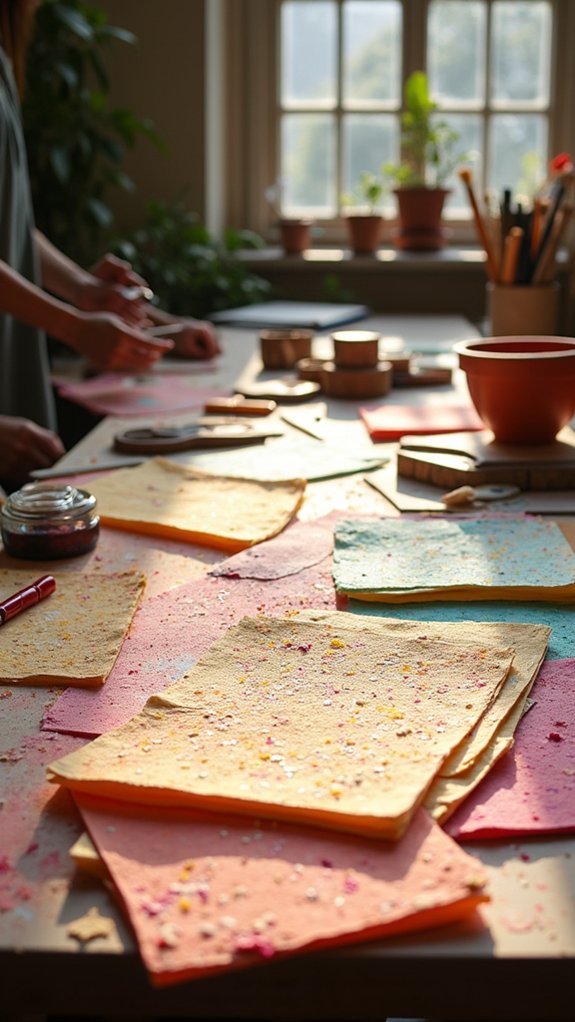
Creating your own paper from recycled materials is a rewarding craft that brings the magic of transformation right into your home.
With just a blender, screen, and some old newspaper or scraps, anyone can make unique sheets that become beautiful cards, envelopes, or journals.
Once you’ve mastered basic papermaking, you’ll have endless possibilities for personalization—adding flower petals, colored threads, or even glitter to make one-of-a-kind stationery that friends will treasure!
Papermaking Basics
Handmade paper, a beautiful craft dating back thousands of years, transforms ordinary materials into extraordinary works of art. This DIY project requires just a few basic supplies and boosts artistic abilities while being eco-friendly!
The papermaking basics involve breaking down cellulose fibers into pulp, then reforming them into unique sheets through pressing and drying.
- Grab a blender, mold and deckle, and a flat drying surface to get started on your paper adventure.
- Customize your creation by adding flower petals, herbs, or food coloring for one-of-a-kind textures and colors.
- Allow 24-48 hours of drying time before using your handmade paper for cool crafts or personalized stationery.
The process is super satisfying, and you’ll feel amazing knowing you’ve created something beautiful while reducing waste!
Decorative Card Ideas
Once your handmade paper has dried completely, transforming it into personalized stationery opens a world of creative possibilities!
Decorative card ideas abound when working with handmade paper, from birthday greetings to thank-you notes that recipients will truly treasure.
Try adding pressed flowers between thin layers of pulp for a gorgeous natural effect, or experiment with stamping techniques to create repetitive patterns.
Kids absolutely love adding buttons, fabric scraps, and colorful washi tape to their cards—it’s like giving a little piece of themselves with every creation!
For an extra-special touch, mix different paper colors and textures in a single card.
The bumpy, unique surface of handmade paper takes watercolors beautifully, creating dreamy backgrounds for handwritten messages.
Clay Modeling: Developing 3D Thinking Through Sculptural Forms
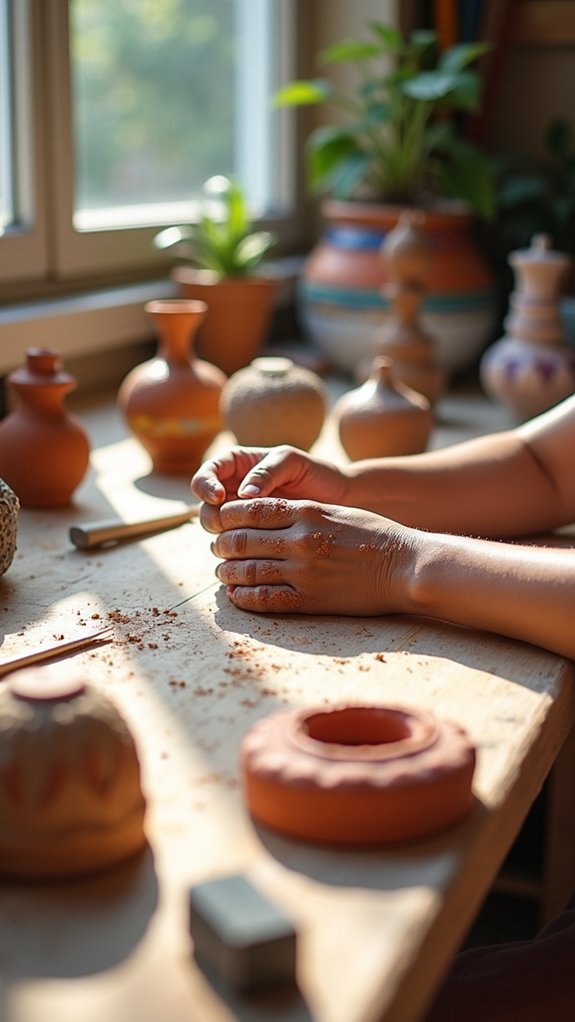
Clay modeling stands as one of the most dynamic forms of artistic expression, inviting artists of all ages to think beyond flat surfaces and venture into the exciting world of three dimensions.
This hands-on activity builds essential fine motor skills while challenging the mind to visualize shapes from all angles. When fingers press, pinch, and shape the clay, they’re actually boosting brain development!
- Transform a simple ball of clay into animals, monsters, or whatever wild creations pop into your imagination!
- Feel stress melt away as your hands squish and mold the cool, responsive material.
- Solve real-world design problems as you figure out how to make your sculpture stand up or create the perfect texture.
The tactile experience of clay modeling creates a special brain-hand connection that digital activities simply can’t match.
Botanical Printing: Capturing Natural Textures With Plant Materials
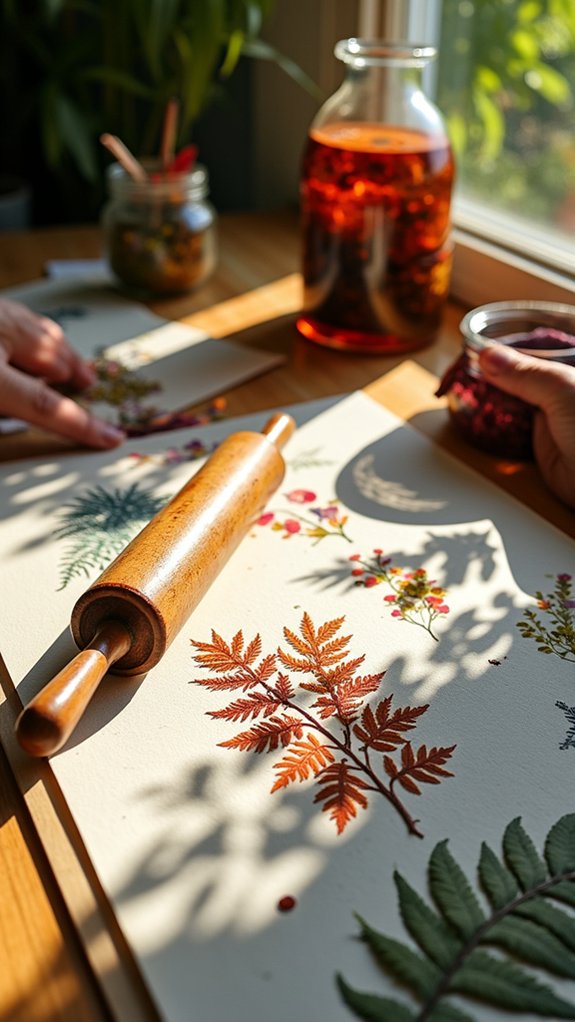
Botanical printing offers an exciting way to create beautiful imprints using leaves, flowers, and other plant materials found right in your backyard or even houseplants.
This nature-inspired technique perfectly blends artistic expression with environmental consciousness, as it requires minimal supplies and produces zero waste.
Anyone can transform ordinary paper or fabric into extraordinary art pieces filled with intricate details and textures that celebrate the wonder of the natural world.
Beautiful Nature Imprints
Many artists and crafters have discovered the magical process of creating botanical prints, where the intricate textures of leaves, petals, and stems become permanent works of art.
These beautiful nature imprints transform ordinary materials into extraordinary treasures that celebrate the wonders of our environment.
The joy of botanical printing comes from:
- Collecting your own leaves and flowers, which turns a simple walk into a treasure hunt
- Experimenting with different plant shapes that leave unique impressions on fabric or paper
- Creating eco-friendly art using water-based inks that won’t harm the environment
The best part? Anyone can try this relaxing craft!
While pressing plant materials onto surfaces, crafters often experience a sense of calm and connection to nature, making botanical printing both a creative outlet and a mindfulness exercise.
Sustainability Meets Art
The wonderful world of botanical printing goes far beyond just making pretty pictures—it’s where art and environmental responsibility come together in perfect harmony.
When sustainability meets art, ordinary leaves and flowers transform into extraordinary patterns on fabric and paper. Kids can collect fallen leaves, arrange them on cloth, and watch as nature’s details get preserved forever!
The best part? This craft uses plants that might otherwise end up in the trash.
Plus, the natural dyes from berries, bark, and flowers replace harmful chemicals, making this a planet-friendly activity. As young artists pound, press, and print with plants, they’ll learn about local trees and flowers while creating awesome gifts.
Who knew that art class could help save the Earth and create beautiful keepsakes at the same time?
Accessible Materials Indoors
Almost everyone has nature’s treasures hiding right inside their home!
Botanical printing transforms simple leaves, flowers, and even kitchen herbs into gorgeous art pieces using accessible materials indoors. With just a cardboard box lid as a work surface, anyone can capture nature’s intricate textures and patterns on paper or fabric.
This creative technique offers:
- A chance to explore plant details up close while creating one-of-a-kind artwork
- Easy adaptation using common supplies like air-dry clay or acrylic paint
- Perfect indoor activity for rainy days or classroom exploration
Digital Art Fusion: Blending Traditional Techniques With Technology
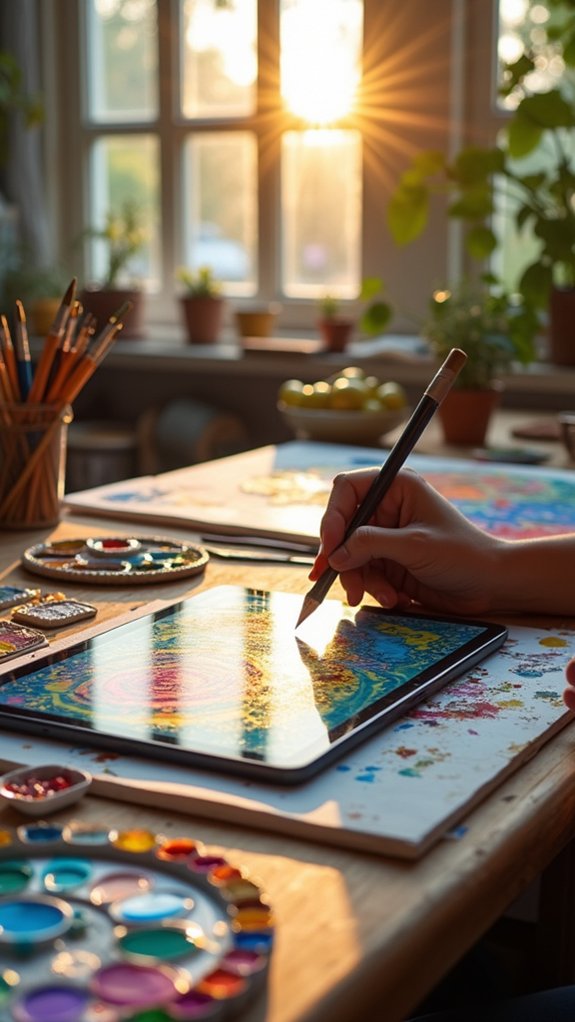
Countless artists today are discovering the exciting world of digital art fusion, where traditional artistic skills meet cutting-edge technology. By scanning hand-drawn sketches or paintings into programs like Photoshop or Procreate, artists can transform their work in ways that weren’t possible before.
The best part? You don’t need fancy equipment to get started!
Digital art fusion lets creators blend textures from real materials—like watercolor splatters or crayon rubbings—with digital effects that pop on screen. It’s like having an infinite art supply cabinet!
Think of digital fusion as your ultimate artistic superpower—unlimited supplies meet infinite undo buttons!
Artists can experiment without wasting materials, quickly trying new ideas with just a few clicks. This awesome combo has opened doors to cool new art forms including 3D models, animations, and even interactive art that responds to viewers.
How cool is that?
Creative Journaling: Combining Visual and Written Expression
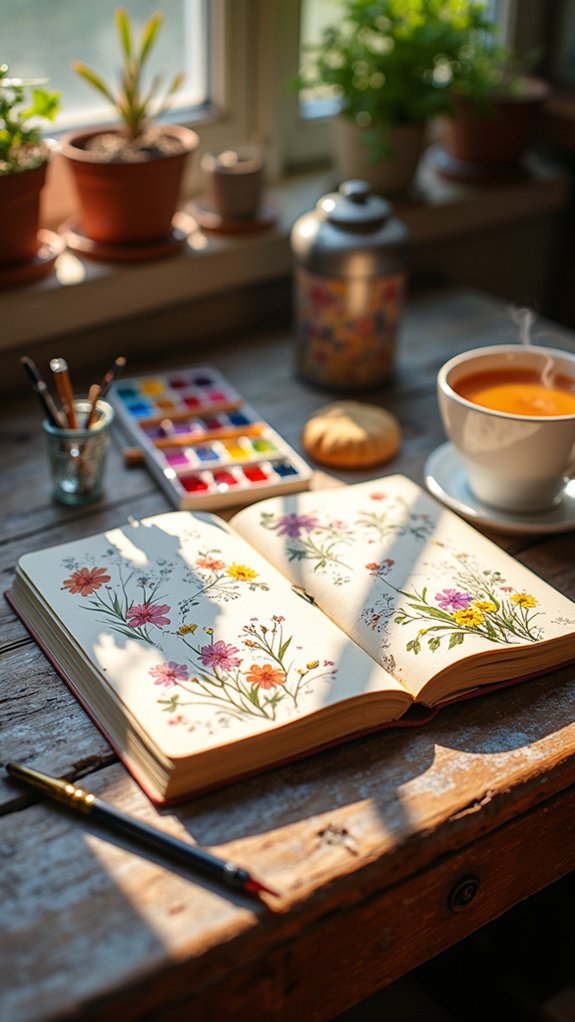
While digital art brings technology into creative practices, another approach lets artists explore both images and words together on paper. Creative journaling combines visual art with writing, offering a powerful way to express thoughts and feelings through colors, drawings, and personal reflections.
This artistic practice serves as both a creative outlet and a therapeutic tool that helps reduce stress and boost emotional awareness.
- Mix watercolors, magazine cutouts, and hand-lettering to create pages that tell your unique story
- Try drawing your emotions when words just aren’t enough
- Use different materials like washi tape, stickers, or pressed flowers to add texture
Research shows that keeping a creative journal regularly can sharpen thinking skills and help people process life experiences in a safe, expressive space.
Frequently Asked Questions
How Does Arts and Crafts Help Creative Development?
Arts and crafts foster creative development by enabling individuals to engage in creative expression, develop problem-solving skills, improve fine motor coordination, and build confidence through experimentation with various materials and techniques.
What Are Craft Ideas for ADHD Adults?
ADHD adults benefit from mindful crafting activities like timed painting sessions, textured clay work, simple knitting projects, and jewelry making that offer dopamine-releasing sensory stimulation while improving focus.
What Is the Newest Craft Craze for Adults?
Resin art stands as the newest craft craze for adults. This versatile medium allows creation of stunning coasters, jewelry, and wall art by mixing resin with pigments and various inclusions.
What Are Examples of Creative Activities?
Creative exploration includes nature collages, DIY storybooks, recycled art projects, paper plate puppets, and beaded jewelry making. These activities foster imagination, resourcefulness, self-expression, communication skills, and environmental awareness for participants.
Conclusion
These art and craft projects aren’t just fun activities—they’re doorways to boundless creativity. By getting hands-on with different materials and techniques, kids discover new talents and ways to express themselves. The best part? There’s no wrong way to create! Whether working alone or with friends, these projects build confidence, problem-solving skills, and a lifelong love of making things. So grab some supplies, get messy, and watch imagination soar!

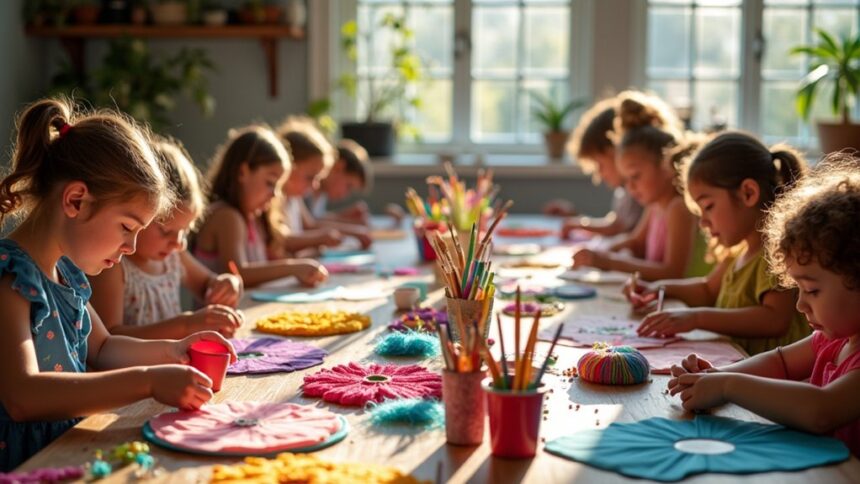
Leave a Reply